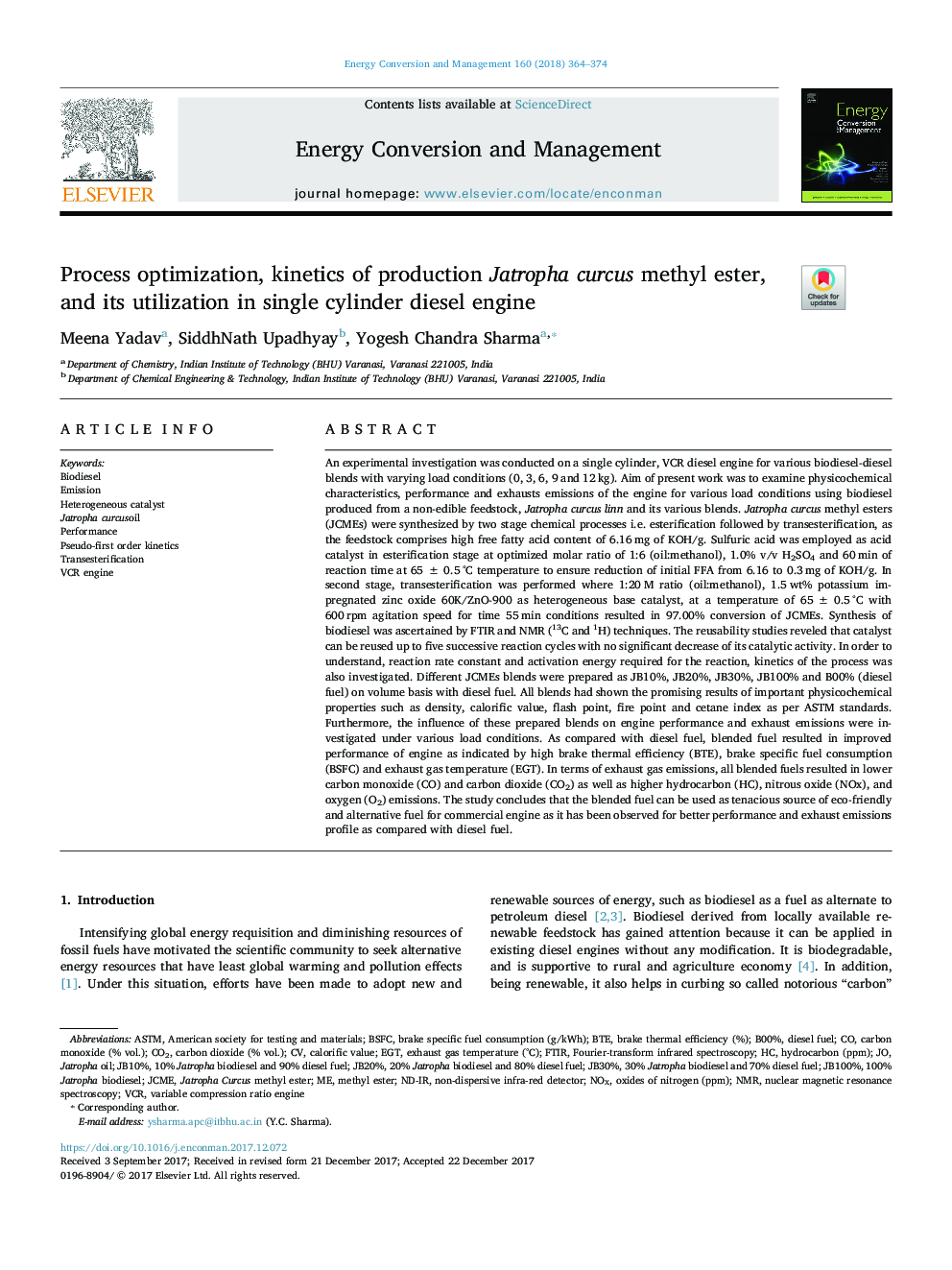| کد مقاله | کد نشریه | سال انتشار | مقاله انگلیسی | نسخه تمام متن |
|---|---|---|---|---|
| 7159026 | 1462802 | 2018 | 11 صفحه PDF | دانلود رایگان |
عنوان انگلیسی مقاله ISI
Process optimization, kinetics of production Jatropha curcus methyl ester, and its utilization in single cylinder diesel engine
دانلود مقاله + سفارش ترجمه
دانلود مقاله ISI انگلیسی
رایگان برای ایرانیان
کلمات کلیدی
ASTMEGTBSFCVCRNOx - NOXEmission - انتشارBiodiesel - بیودیزلTransesterification - تبادل استریFourier-transform infrared spectroscopy - تبدیل فوریه طیف سنجی مادون قرمزNMR - تشدید مغناطیسی هستهای American society for testing and materials - جامعه آمریکایی برای آزمایش و موادJatropha oil - روغن JatrophaDiesel fuel - سوخت دیزلPseudo-first order kinetics - سینتیک تکرار شبه درجه اولFTIR - طیف سنج مادون قرمزNuclear magnetic resonance spectroscopy - طیف سنجی رزونانس مغناطیسی هسته ایMethyl ester - متیل استرCalorific value - مقدار گرماBTE - وسایل کمکHeterogeneous catalyst - کاتالیزور ناهمگنPerformance - کاراییCO2 - کربن دیاکسید
موضوعات مرتبط
مهندسی و علوم پایه
مهندسی انرژی
انرژی (عمومی)
پیش نمایش صفحه اول مقاله

چکیده انگلیسی
An experimental investigation was conducted on a single cylinder, VCR diesel engine for various biodiesel-diesel blends with varying load conditions (0, 3, 6, 9 and 12â¯kg). Aim of present work was to examine physicochemical characteristics, performance and exhausts emissions of the engine for various load conditions using biodiesel produced from a non-edible feedstock, Jatropha curcus linn and its various blends. Jatropha curcus methyl esters (JCMEs) were synthesized by two stage chemical processes i.e. esterification followed by transesterification, as the feedstock comprises high free fatty acid content of 6.16â¯mg of KOH/g. Sulfuric acid was employed as acid catalyst in esterification stage at optimized molar ratio of 1:6 (oil:methanol), 1.0% v/v H2SO4 and 60â¯min of reaction time at 65â¯Â±â¯0.5â¯Â°C temperature to ensure reduction of initial FFA from 6.16 to 0.3â¯mg of KOH/g. In second stage, transesterification was performed where 1:20â¯M ratio (oil:methanol), 1.5â¯wt% potassium impregnated zinc oxide 60K/ZnO-900 as heterogeneous base catalyst, at a temperature of 65â¯Â±â¯0.5â¯Â°C with 600â¯rpm agitation speed for time 55â¯min conditions resulted in 97.00% conversion of JCMEs. Synthesis of biodiesel was ascertained by FTIR and NMR (13C and 1H) techniques. The reusability studies reveled that catalyst can be reused up to five successive reaction cycles with no significant decrease of its catalytic activity. In order to understand, reaction rate constant and activation energy required for the reaction, kinetics of the process was also investigated. Different JCMEs blends were prepared as JB10%, JB20%, JB30%, JB100% and B00% (diesel fuel) on volume basis with diesel fuel. All blends had shown the promising results of important physicochemical properties such as density, calorific value, flash point, fire point and cetane index as per ASTM standards. Furthermore, the influence of these prepared blends on engine performance and exhaust emissions were investigated under various load conditions. As compared with diesel fuel, blended fuel resulted in improved performance of engine as indicated by high brake thermal efficiency (BTE), brake specific fuel consumption (BSFC) and exhaust gas temperature (EGT). In terms of exhaust gas emissions, all blended fuels resulted in lower carbon monoxide (CO) and carbon dioxide (CO2) as well as higher hydrocarbon (HC), nitrous oxide (NOx), and oxygen (O2) emissions. The study concludes that the blended fuel can be used as tenacious source of eco-friendly and alternative fuel for commercial engine as it has been observed for better performance and exhaust emissions profile as compared with diesel fuel.
ناشر
Database: Elsevier - ScienceDirect (ساینس دایرکت)
Journal: Energy Conversion and Management - Volume 160, 15 March 2018, Pages 364-374
Journal: Energy Conversion and Management - Volume 160, 15 March 2018, Pages 364-374
نویسندگان
Meena Yadav, SiddhNath Upadhyay, Yogesh Chandra Sharma,